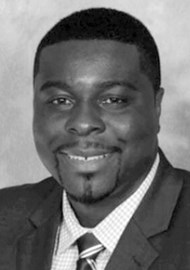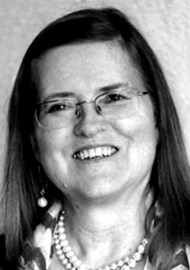Addressing the medical desert with tele-audiology and tele-education.
If a ‘medical desert’ is defined as a community that lives more than 60 miles away from the nearest acute care hospital, then try to imagine an appropriate term for a situation in which one audiologist serves an entire country with a population of 18 million.
Reality quickly sets in after internalising the staggering numbers of communicable diseases (HIV/AIDS, tuberculosis, cholera), non-communicable diseases (malaria), infant mortality rates (associate to inaccessible maternal health facilities), and insufficient hygiene practices, in addition to health conditions that are prevalent in Zambia [1]. In other words, those conditions that threaten human mortality, likewise can easily threaten quality of life with diminished hearing and ear health. Zambia’s health resource paucity is a stark contrast to its remarkable natural resources that makes it one of the largest African mining countries, especially in the Copperbelt region of Northern Zambia.
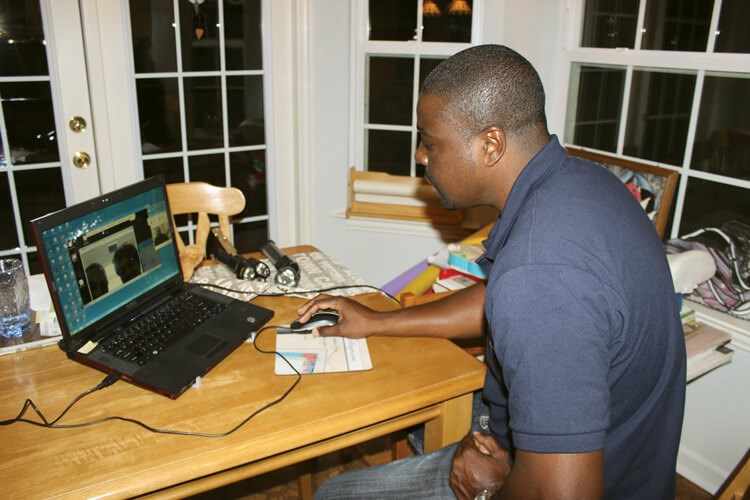
Dr Mwamba while in Texas interacting with his team in Zambia as they are testing a patient.
In the beginning
Zambia’s daunting health statistics have never been lost on the only audiologist, who was born and raised in the country, and then returned home after a six-year absence while obtaining graduate education in audiology in the United States. Of the utmost priority was building collaboration with various non-profit health and hearing care organisations while simultaneously engaging the Zambia health sector. Eventually the government could see the value in partnering with non-profit organisations (such as: Beit Cure Hospital, Sound Seekers, CBM, and Starkey Hearing Foundation) to establish ear and hearing care services across the country through a National Ear, Nose and Throat Strategic Plan (NENTSP).
“Try to imagine an appropriate term for a situation in which one audiologist serves an entire country with a population of 18 million”
Recognising the impossibilities of one serving 18 million people, the task of raising government awareness about possible audiology services whilst simultaneously providing a variety of community outreach programmes created a seemingly impossible circle. Like many other low- and middle-income countries, a natural well-established human resource of clinical officers (physician assistants) and nurses in hospitals and clinics with relevant training is recognised within the Zambian health system. These professionals are already positioned to pivot into ear and hearing care through up-skill (task sharing) instead of trying to immediately create and fill the vast spaces specific for audiology professionals (or budgeting for another tier of professionals within their health system).
Training
An obvious advantage of up-skilling nurses lies in their core didactic and clinical training of foreign body removal, cerumen management, anatomy and physiology of the outer ear, and basic treatment of ear disease. Their foundational knowledge easily positioned them for specialising in hearing care. Therefore, any newer skills acquired complemented their already existing skills through side-by-side, often with clinical officers as preceptors’ during clinical patient interaction through tele-audiology.
The proof of concept of utilising tele-audiology for education, observation and critiquing trainees’ abilities in testing and counselling was proven successful with a one-time engagement from Dallas, Texas (USA) to Lusaka, Zambia during an afternoon clinic, entailing trainees testing and counselling of patients by the authors of this article. A few months later, a licensed and experienced audiologist from Cape Town, South Africa, Mrs Shannon Kruyt O’Leary, was enlisted as a long-term consultant and remote trainer. Equipment for the ongoing training included: the computer-based and portable (boothless) audiometer KuduWave© (eMoyoTM; Johannesburg, South Africa) equipped with 3G mobile internet services and TeamViewer© software for both synchronous and asynchronous mode of use. The KuduWave© is a tele-audiology-enabled audiometer built with dual functioning headset for air (insert receivers inside active noise reduction attenuating cups) and bone conduction, and speech testing. An addition of a remote trainer partnering with the sole audiologist in Zambia, made multiple activities possible (both remote and local) to occur simultaneously in different locations.
“An addition of a remote trainer partnering with the sole audiologist in Zambia, made multiple activities possible (both remote and local) to occur simultaneously in different locations”
As part of the training programme, the audiologist trainers, either from Lusaka or Cape Town, would connect and observe/assist as needed in a scheduled clinical testing session at Ndola Central Hospital with the more difficult patients requiring advanced diagnostic techniques (such as masking with unilateral hearing loss or patients with bothersome tinnitus). Not only was this approach a great learning opportunity for nurses undergoing training in diagnostic audiometric evaluation, but it also facilitated the scheduled weekly remote hearing aid programming sessions. It is important to note that modes for proof of competence were also utilised through written, practical and oral exams, with a ‘pass’ criterion of 80% attained by all trainees to eventually complete hearing care specialist nurse or clinical officer training.
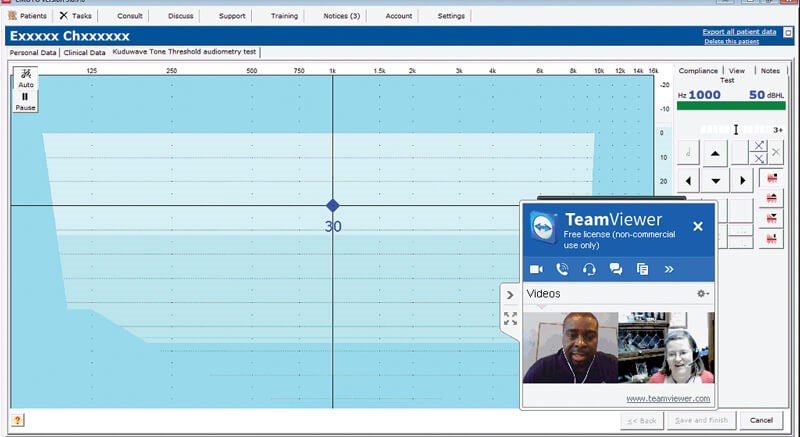
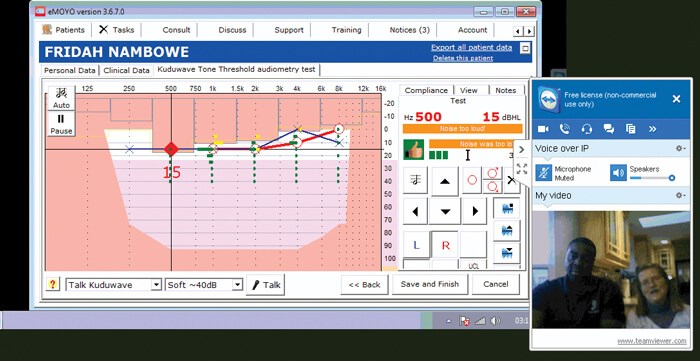
Alfred Mwamba (in Zambia) and Jackie Clark (in Texas) on teleconference during the
proof of concept while working through some technical aspects of the KuduWave.
Graduates
Many of the early graduates of the programme are now in remote locations without nearby ear and hearing care specialists. It is unsurprising that on occasion they would find themselves with a puzzling case and seeking assistance regarding results. With their foundational tele-audiology training, they could easily lean into asynchronous tele-audiology to share data, otoscopy photos and/or seek consultation with another ear and hearing care specialist graduate or instructor from afar.
In 2016, the Starkey Hearing Institute in Lusaka was created by the Starkey Foundation with funding to go towards educating and empowering this new tier of ear and hearing specialists within Zambia. Since then, each cohort of trainees has been assured access to a clinical team comprised of former graduates along with invited and paid lecturers for on-site, video conferencing, or tele-audiology programmatic support. Additionally, with the precipitous addition of ear and hearing specialists employed throughout Zambia, new trainees are also assured of an expanded hands-on exposure of more than 200 hours of direct line of sight supervised clinical practicum in a variety of practices in addition to synchronous tele-audiology, as needed.
Currently, there are 12 nurses and one clinical officer with ear and hearing specialisation sanctioned by the Ministry of Health of Zambia to engage in hearing assessments and hearing aid fittings. Additionally, eight non-medical clinicians are working in the private sector. All nurses who have graduated from the programme are dedicated solely to ear and hearing care in their hospitals. In almost all cases, the specialised ear and hearing nurses oversee audiology units in their government clinics and hospitals. As an added resource, consultant ENT surgeons have provided training to the nurses while using the WHO Training Program on Ear and Hearing Care [2] to improve management and treatment of ear diseases within the allowable scope of a nurse or a clinical officer whilst under the supervision of a physician specialist. Unfortunately, when there is a shortage of nursing staff, as has been the case during this COVID-19 pandemic, the nurses are often deployed to the pandemic response unit to assist in COVID service delivery.
Future possibilities and challenges
Tele-audiology opportunities abound as a direct result from lessons learned over the years. Like nurses within the health setting, special education teachers can greatly enhance service provision and support to school pupils who have hearing loss. When looking to the future for additional avenues of training, another readily available human resource in Zambia is special education teachers who could serve as educational hearing care specialists within the school system. In such a setting as a school, tele-audiology could certainly enhance not only training for the educational hearing care specialists, but also create a linkage of support by audiologists in the tertiary facilities, directly to the learners.
“Tele-audiology should be viewed as a bridge in the establishment of service in underserved areas and not viewed as the sole mode of service delivery to a large population”
As the world has realised during the pandemic, learners still prefer face-to-face training modes for a variety of reasons; not the least is comfort in using the computing technology that is dependent upon strong connectivity to internet and electricity.
Unsurprisingly, clinicians, teachers, lecturers and trainees have also experienced those challenges with computers. However, having a full-time programme has been more successful in enhancing competency in the graduates, with tele-audiology as a support system and not as the primary mode of training. Tele-audiology should be viewed as a bridge in the establishment of service in underserved areas and not viewed as the sole mode of service delivery to a large population. However, every area’s needs should be individually assessed on the most appropriate means of service development.
References
1. Ministry of Health Lusaka. National Human Resources for Health Strategic Plan 2011-2015.
www.who.int/workforcealliance/countries/
ccf/HRH_plan_zambia2011-2015.pdf?ua=1
2. World Health Organization. Primary Ear and Hearing Care Training Resource – Training Manual. Geneva, Switzerland; WHO Press; 2006.
www.who.int/pbd/deafness/activities/
hearing_care/trainer.pdf?ua=1
Links last accessed April 2021.


